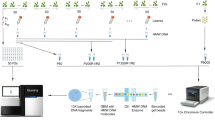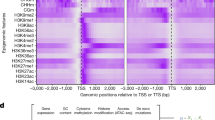Abstract
Linkage disequilibrium (LD) is a major aspect of the organization of genetic variation in natural populations. Here we describe the genome-wide pattern of LD in a sample of 19 Arabidopsis thaliana accessions using 341,602 non-singleton SNPs. LD decays within 10 kb on average, considerably faster than previously estimated. Tag SNP selection algorithms and 'hide-the-SNP' simulations suggest that genome-wide association mapping will require only 40%–50% of the observed SNPs, a reduction similar to estimates in a sample of African Americans. An Affymetrix genotyping array containing 250,000 SNPs has been designed based on these results; we demonstrate that it should have more than adequate coverage for genome-wide association mapping. The extent of LD is highly variable, and we find clear evidence of recombination hotspots, which seem to occur preferentially in intergenic regions. LD also reflects the action of selection, and it is more extensive between nonsynonymous polymorphisms than between synonymous polymorphisms.
This is a preview of subscription content, access via your institution
Access options
Subscribe to this journal
Receive 12 print issues and online access
$209.00 per year
only $17.42 per issue
Buy this article
- Purchase on Springer Link
- Instant access to full article PDF
Prices may be subject to local taxes which are calculated during checkout




Similar content being viewed by others
References
Clark, R.M. et al. Common sequence polymorphisms shaping genetic diversity in Arabidopsis thaliana. Science 317, 338–342 (2007).
Nordborg, M. et al. The pattern of polymorphism in Arabidopsis thaliana. PLoS Biol. 3, e196 (2005)(doi:10.1371/journal.pbio.0030196).
Plagnol, V., Padhukasharam, B., Marjoram, P., Wall, J.D. & Nordborg, M. Relative influences of crossing-over and gene conversion on the pattern of linkage disequilibrium in Arabidopsis thaliana. Genetics 172, 2441–2448 (2006).
Nordborg, M. Linkage disequilibrium, gene trees, and selfing: An ancestral recombination graph with partial self-fertilization. Genetics 154, 923–929 (2000).
Hudson, R.R. Two-locus sample distributions and their applications. Genetics 159, 1805–1817 (2001).
Padhukasahasram, B., Wall, J.D., Marjoram, P. & Nordborg, M. Estimating recombination rates from single-nucleotide polymorphisms using summary statistics. Genetics 174, 1517–1528 (2006).
Haddrill, P.R., Thornton, K.R., Charlesworth, B. & Andolfatto, P. Multilocus patterns of nucleotide variability and the demographic and selection history of Drosophila melanogaster populations. Genome Res. 15, 790–799 (2005).
Przeworski, M. & Wall, J.D. Why is there so little intragenic linkage disequilibrium in humans? Genet. Res. 77, 143–151 (2001).
Frisse, L. et al. Gene conversion and different population histories may explain the contrast between polymorphism and linkage disequilibrium levels. Am. J. Hum. Genet. 69, 831–843 (2001).
Hagenblad, J. & Nordborg, M. Sequence variation and haplotype structure surrounding the flowering time locus FRI in Arabidopsis thaliana. Genetics 161, 289–298 (2002).
Haubold, B., Kroymann, J., Ratzka, A., Mitchell-Olds, T. & Wiehe, T. Recombination and gene conversion in a 170-kb genomic region of Arabidopsis thaliana. Genetics 161, 1269–1278 (2002).
Hinds, D.A. et al. Whole-genome patterns of common DNA variation in three human populations. Science 307, 1072–1079 (2005).
de Bakker, P.I.W. et al. Efficiency and power in genetic association studies. Nat. Genet. 37, 1217–1223 (2005).
Johnson, G.C. et al. Haplotype tagging for the identification of common disease genes. Nat. Genet. 29, 233–237 (2001).
Zondervan, K.T. & Cardon, L.R. The complex interplay among factors that influence allelic association. Nat. Rev. Genet. 5, 89–100 (2004).
International HapMap Consortium. A haplotype map of the human genome. Nature 437, 1299–1320 (2005).
Wall, J.D. & Pritchard, J.K. Haplotype blocks and linkage disequilibrium in the human genome. Nat. Rev. Genet. 4, 587–597 (2003).
Arnheim, N., Calabrese, P. & Nordborg, M. Hot and cold spots of recombination in the human genome: The reason we should find them and how this can be achieved. Am. J. Hum. Genet. 73, 5–16 (2003).
Drouaud, J. et al. Variation in crossing-over rates across chromosome4 of Arabidopsis thaliana reveals the presence of meiotic recombination hot spots. Genome Res. 16, 106–114 (2006).
Schmuths, H., Meister, A., Horres, R. & Bachmann, K. Genome size variation among accessions of Arabidopsis thaliana. Ann. Bot. (Lond.) 93, 317–321 (2004).
Nordborg, M. & Tavaré, S. Linkage disequilibrium: what history has to tell us. Trends Genet. 18, 83–90 (2002).
Hudson, R.R. & Kaplan, N.L. Statistical properties of the number of recombination events in the history of a sample of DNA sequences. Genetics 111, 147–164 (1985).
Andolfatto, P. Adaptive evolution of non-coding DNA in Drosophila. Nature 437, 1149–1152 (2005).
Li, N. & Stephens, M. Modeling linkage disequilibrium and identifying recombination hotspots using single-nucleotide polymorphism data. Genetics 165, 2213–2233 (2003).
Hudson, R.R. Generating samples under a Wright-Fisher neutral model. Bioinformatics 18, 337–338 (2002).
Andolfatto, P. & Nordborg, M. The effect of gene conversion on intralocus associations. Genetics 148, 1397–1399 (1998).
Barrett, J.C., Fry, B., Maller, J. & Daly, M.J. Haploview: analysis and visualization of LD and haplotype maps. Bioinformatics 21, 263–265 (2005).
Acknowledgements
Support was provided by grants from the US National Institutes of Health (HG002790 to M. Waterman, GM62932 to D.W. and a postdoctoral fellowship to C.T.) and the US National Science Foundation (DEB-0115062 to M.N.) and by funds from the Max Planck Society. D.W. is a director of the Max Planck Institute.
Author information
Authors and Affiliations
Contributions
S.K., V.P., T.T.H. and C.T. carried out all the population genetics analyses and assisted with writing the paper. R.M.C. and S.O. analyzed the raw array data. J.R.E. and D.W. directed the array resequencing project. M.N. directed the population genetics analyses and wrote the paper. All authors commented on and revised the manuscript.
Corresponding author
Ethics declarations
Competing interests
The authors declare no competing financial interests.
Supplementary information
Supplementary Text and Figures
Supplementary Figures 1–5, Supplementary Table 1, Supplementary Methods (PDF 1475 kb)
Rights and permissions
About this article
Cite this article
Kim, S., Plagnol, V., Hu, T. et al. Recombination and linkage disequilibrium in Arabidopsis thaliana. Nat Genet 39, 1151–1155 (2007). https://doi.org/10.1038/ng2115
Received:
Accepted:
Published:
Issue Date:
DOI: https://doi.org/10.1038/ng2115
This article is cited by
-
Dissecting genetic variation and association mapping for agro-morphological traits under high temperature stress in pea (Pisum sativum L.)
Euphytica (2024)
-
Association mapping in bambara groundnut [Vigna subterranea (L.) Verdc.] reveals loci associated with agro-morphological traits
BMC Genomics (2023)
-
Single-gene resolution of diversity-driven overyielding in plant genotype mixtures
Nature Communications (2023)
-
Why do plants need the ZMM crossover pathway? A snapshot of meiotic recombination from the perspective of interhomolog polymorphism
Plant Reproduction (2023)
-
The megabase-scale crossover landscape is largely independent of sequence divergence
Nature Communications (2022)



